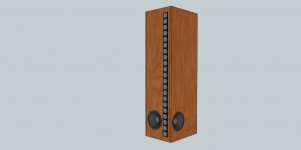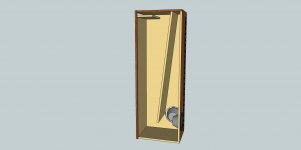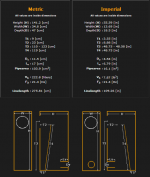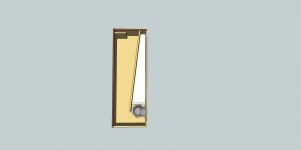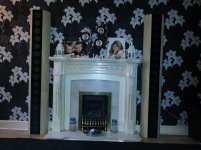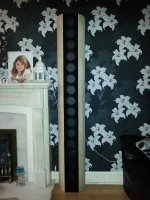I know this is in the Multi-way forum, but this design is here because the design is technically two way, utilizing a woofer and a full range driver. So its kind of a mixed beast.
This is just a design I came up with. It utilizes 21 HiWave BMR12 full range drivers crossed over at somewhere between 200-300 hertz.The final value has not been decided. For the woofer, is a Dayton Audio SD-215A woofer. I wanted to play around with the idea of a line array, but I have built a full-ranger all ready (the WIBAQ) and I like the qualities of a full range set-up. I did, however, also want to free up the full rangers from handling the bass (because I like bass and I like it loud)
So here are some preliminary sketchup shots of the speaker. There will be bracing added. The material being used is 3/4 MDF or plywood. I don't plan on building this any time soon since I am away at college, but wanted to come up with a design for fun.
Feedback?
Also, how would I figure out how to wire up the fullrange drivers so that they pair well with the woofers?
This is just a design I came up with. It utilizes 21 HiWave BMR12 full range drivers crossed over at somewhere between 200-300 hertz.The final value has not been decided. For the woofer, is a Dayton Audio SD-215A woofer. I wanted to play around with the idea of a line array, but I have built a full-ranger all ready (the WIBAQ) and I like the qualities of a full range set-up. I did, however, also want to free up the full rangers from handling the bass (because I like bass and I like it loud)
So here are some preliminary sketchup shots of the speaker. There will be bracing added. The material being used is 3/4 MDF or plywood. I don't plan on building this any time soon since I am away at college, but wanted to come up with a design for fun.
Feedback?
Also, how would I figure out how to wire up the fullrange drivers so that they pair well with the woofers?
Attachments
Last edited:
-treble region will be missing in action unless you boost the higher freq.s, or pad-down the midrange.
This project helps describe the sort of midrange boost you'll have:
Parts Express: Project Showcase
-unless the fullrange BMR's are "closed back" you shouldn't have them connected to the same air space as the "subs".
-consider fairly large radius edges (fillet) for at least the sides of the front baffle to substantially lower diffraction. This place has plywood and mdf for this:
QUARTER ROUNDS
-I'd probably wire the full-range's in groups of 7 - all in series, then wire the 3 groups together in parallel.. Or parallel 3 drivers and then wire those 7 groups together in series.
This project helps describe the sort of midrange boost you'll have:
Parts Express: Project Showcase
-unless the fullrange BMR's are "closed back" you shouldn't have them connected to the same air space as the "subs".
-consider fairly large radius edges (fillet) for at least the sides of the front baffle to substantially lower diffraction. This place has plywood and mdf for this:
QUARTER ROUNDS
-I'd probably wire the full-range's in groups of 7 - all in series, then wire the 3 groups together in parallel.. Or parallel 3 drivers and then wire those 7 groups together in series.
Last edited:
-treble region will be missing in action unless you boost the higher freq.s, or pad-down the midrange.
This project helps describe the sort of midrange boost you'll have:
Parts Express: Project Showcase
-unless the fullrange BMR's are "closed back" you shouldn't have them connected to the same air space as the "subs".
-consider fairly large radius edges (fillet) for at least the sides of the front baffle to substantially lower diffraction. This place has plywood and mdf for this:
QUARTER ROUNDS
-I'd probably wire the full-range's in groups of 7 - all in series, then wire the 3 groups together in parallel.. Or parallel 3 drivers and then wire those 7 groups together in series.
Thanks for the suggestions.
So with a TQWT, would adding a separate box for the full rangers like pictured create issues with the change in volume? or would the change not be too detrimental? The partition is about 4.5 inches wideand follows the angle of the fold for the TQWT.
Also, I can see what you're saying about the hump in the mid range response. What would be a good way to get rid of that? Would an RLC based circuit work or would that be too complicated?
Attachments
Last edited:
So with a TQWT, would adding a separate box for the full rangers like pictured create issues with the change in volume?
Also, I can see what you're saying about the hump in the mid range response. What would be a good way to get rid of that? Would an RLC based circuit work or would that be too complicated?
Because of the line's length, you would need to move your side-mounted woofer over to the other side-panel (..to continue the enclosure).
As far as the result on the woofer's - I don't know, but it doesn't seem like that much of a change in volume. Best to model it Martin King's spreadsheets:
MathCad Computer Models : Upgraded Versions
Yes.
https://www.google.com/search?q=ban...uqwHEvYAo&ved=0CDYQsAQ&biw=1227&bih=663&dpr=1
http://sim.okawa-denshi.jp/en/RLCbekeisan.htm
Note though that the average efficiency (if filtered properly) will be that of only *one* of your full-range drivers. (..on the other hand because it's a line source you won't get the kind of pressure loss with distance like you would with a point-source.)
BMR and line array...On wall if possible.
Hi Dumbledog,
The little BMR
HiWave BMR12 Compact 2" Full-Range Square Speaker 12W 8 Ohm 297-210
you have chosen is a great buy at $20.00....At $6.00 its a screaming bargain!!
The broad off axis / in room power response is fab and perfectly suited to on wall mounted line arrays.
Its low power handling and tiny Sd ( usable cone surface area ) can be mitigated to a large extent by using approx. 16 to 24 drivers per side and crossing over to a remote sub around 80Hz to 120 Hz at the most.
If crossing over any higher you will need to build in a good 10 inch to 15 inch Pro bass driver into the main line array, or build a 2 piece system with the bass driver in a separate cabinet(s) but located immediately below the main line array cabinet.
I am using a bigger ( 4.5 inch) Neo magnet open backed BMR driver in a line array...I love them...best overall speaker system I have ever made!
Good luck and pls post some photo's and your impressions of how it all sounds!
Cheers
Derek.
Hi Dumbledog,
The little BMR
HiWave BMR12 Compact 2" Full-Range Square Speaker 12W 8 Ohm 297-210
you have chosen is a great buy at $20.00....At $6.00 its a screaming bargain!!
The broad off axis / in room power response is fab and perfectly suited to on wall mounted line arrays.
Its low power handling and tiny Sd ( usable cone surface area ) can be mitigated to a large extent by using approx. 16 to 24 drivers per side and crossing over to a remote sub around 80Hz to 120 Hz at the most.
If crossing over any higher you will need to build in a good 10 inch to 15 inch Pro bass driver into the main line array, or build a 2 piece system with the bass driver in a separate cabinet(s) but located immediately below the main line array cabinet.
I am using a bigger ( 4.5 inch) Neo magnet open backed BMR driver in a line array...I love them...best overall speaker system I have ever made!
Good luck and pls post some photo's and your impressions of how it all sounds!
Cheers
Derek.
Attachments
- Status
- This old topic is closed. If you want to reopen this topic, contact a moderator using the "Report Post" button.
